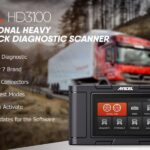Are you a car enthusiast looking to monitor your vehicle’s performance in real-time? The Esp32 Bluetooth Obd2 gauge offers a DIY solution to display crucial engine data right in your car. This project combines the power of the ESP32 microcontroller with the versatility of OBD2 (On-Board Diagnostics II) to create a customizable and informative gauge. By leveraging Bluetooth connectivity, this gauge wirelessly retrieves data from your car’s OBD2 port and presents it on a user-friendly display.
Hardware Components for Your ESP32 OBD2 Gauge
Building your own ESP32 Bluetooth OBD2 gauge requires a few key hardware components. First, you’ll need an ESP32 TFT2.8 320×240 display with a resistive touch screen. This serves as the brain and visual interface for your gauge. It’s important to ensure you choose a model with a resistive touch screen for user interaction. You can find suitable displays at online retailers like AliExpress.
Image: Example display screens of the ESP32 Bluetooth OBD2 gauge showcasing different data layouts and real-time vehicle information.
Next, an ELM327 Bluetooth adapter is essential for communicating with your car’s OBD2 system. It is highly recommended to use version 1.5 of the ELM327 adapter for optimal compatibility and performance, rather than version 2.1. This adapter plugs into your car’s OBD2 port and wirelessly transmits vehicle data via Bluetooth. A small speaker (1 Watt 8 ohm) can be added for audible warnings or notifications. A push button (6x6x5 2 legs) is used for user input and menu navigation.
Image: Configuration screen of the ESP32 Bluetooth OBD2 gauge demonstrating customizable settings and parameters.
To house all the electronics neatly, a 3D-printed enclosure is recommended. This provides protection and a professional look to your DIY gauge. Powering the system requires a 12V to 5V DC micro USB power regulator module to step down your car’s 12V power to the 5V needed for the ESP32 and display. Finally, a gauge magnetic stand allows for easy mounting of your new OBD2 gauge in your vehicle.
Image: 3D printed enclosure designed for the ESP32 Bluetooth OBD2 gauge, showing a compact and custom housing solution.
Software and Features of the ESP32 OBD2 Gauge
The software side of this project is based on the Arduino IDE and the ESP32 Arduino core. Specifically, Arduino IDE 2.3.2 and ESP32 Arduino core 2.0.17 are required. It’s crucial to note that this project is not compatible with ESP32 Arduino core versions 3.x.x. Additionally, a modified version of the TFT_eSPI library 2.5.43 is used for display control.
This ESP32 Bluetooth OBD2 gauge boasts a range of features, including displaying seven key vehicle parameters (PIDs): Manifold Air Pressure (MAP), PCM Voltage, Engine Load, Engine Speed (RPM), Coolant Temperature, Oil Temperature, and Ford Transmission Fluid Temperature (TFT). Users can select from 8 different layout pages to customize the display of this data. The gauge also supports DTC (Diagnostic Trouble Code) reading and clearing for engine warning lights. Warning thresholds can be set for each PID, and the gauge includes configurable CPU overheat protection and auto screen brightness. Users can even customize the off-screen display with images from a micro SD card. Firmware updates are supported via both micro SD card and WiFi, and the gauge can read the vehicle’s VIN (Vehicle Identification Number) on the About page.
Firmware Installation
Flashing the firmware to your ESP32 is straightforward. You can directly flash the firmware using the web installer available at: https://vaandcob.github.io/ESP32-OBD2-Gauge/sketch/firmware/webinstall.html
Support the Project
If you find this ESP32 Bluetooth OBD2 gauge project useful and want to support the creator, you can buy them a coffee: ☕ Buy me coffee
This DIY ESP32 Bluetooth OBD2 gauge is a fantastic project for anyone interested in car diagnostics and real-time performance monitoring. Its customizable features and wireless connectivity make it a valuable tool for understanding your vehicle’s operation.
